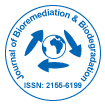Research Article
Decolorization of Triphenylmethane Dyes by Six White-Rot Fungi Isolated from Nature
| Kavita Vasdev* | |
| Department of Microbiology, Gargi College, New Delhi, India | |
| Corresponding Author : | Dr. Kavita Vasdev Associate Professor Department of Microbiology Gargi College, New Delhi, India E-mail: vasdevkavi@yahoo.com |
| Received September 09, 2011; Accepted October 27, 2011; Published October 29, 2011 | |
| Citation: Vasdev K (2011) Decolorization of Triphenylmethane Dyes by Six White- Rot Fungi Isolated from Nature. J Bioremed Biodegrad 2:128. doi:10.4172/2155-6199.1000128 | |
| Copyright: © 2011 Vasdev K. This is an open-access article distributed under the terms of the Creative Commons Attribution License, which permits unrestricted use, distribution, and reproduction in any medium, provided the original author and source are credited. | |
Related article at Pubmed Pubmed  Scholar Google Scholar Google |
|
Abstract
The ability to decolorize three Triphenyl methane dyes (crystal violet, Bromophenol blue and Malachite green) by six white rot fungi, isolated from nature, was evaluated in liquid media. All six-fungi showed high decolorization capacity and were able to decolorize all three dyes within 72 hours. All six fungal strains not only decolorized these dyes, they also showed varied levels of laccase production during decolorization. Their growth was not affected much by presence of dyes in the medium. Three of these fungi were found to have capacity to decolorize as high as 6g/L concentration of these dyes. Out of the three dyes tested here, Malachite green was decolorized fastest. The dyes were not just being decolorized; they were actually being degraded as was evident from their UV-Visible Spectra. Furthermore, the fungi degraded these dyes without accumulating any phenolic compounds.

 Spanish
Spanish  Chinese
Chinese  Russian
Russian  German
German  French
French  Japanese
Japanese  Portuguese
Portuguese  Hindi
Hindi 
